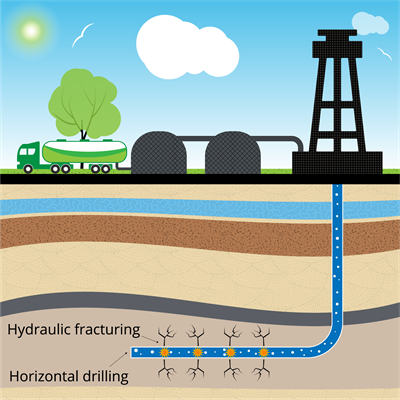PDF chapter test TRY NOW
Natural gas is a hydrocarbon gas mainly composed of methane and other higher alkanes, with minor amounts of carbon dioxide, nitrogen and hydrogen sulphide (\(H_2S\)).
Dry gas is defined as natural gas that has lower levels of hydrocarbons, such as methane and ethane. Wet gas is defined as a gas that contains higher hydrocarbons, such as propane and butane.
In oil wells, natural gas is always found above the oil. This gas is trapped inside reservoirs, which are small spaces in underground rocks. Drilling wells can be used to extract conventional natural gas.
Natural gas is also found in oil reservoirs and is extracted alongside the oil. This is known as related gas.
Natural gas is a fossil fuel that is used for heating, cooking and generating electricity. Natural gas occurs in Tripura, Rajasthan, Maharashtra, Andhra Pradesh (Krishna, Godavari Basins) and Tamil Nadu (Cauveri Delta).
Decomposition of organic substances in marshy places and waste sewages also contribute to its formation. The natural gas produced in this manner is mostly methane.

Extraction of natural gas
Uses of natural gases:
Natural gas is used as an industrial and domestic fuel.
- It decomposes into hydrogen and carbon when heated. Fertilisers are made from the hydrogen produced in this way.
- It is used in the production of chemicals, fabrics, glass, steel, plastics, paints, as well as in the generation of electricity.
- Paintings and other ancient artefacts must be kept at a moderate temperature and humidity to avoid being damaged by environmental factors. Thus, museums use natural gas to conserve their artefacts.
Advantages of natural gases:
- Natural gas generates a lot of heat since it is quickly burned.
- It does not leave any residues.
- It does not produce smoke and, hence, does not pollute the environment.
- This can be simply provided via pipes.
- It can be utilised as a source of fuel in both homes and industries.
Compressed Natural gas (CNG)
When the natural gas is compressed at high pressure, it is called Compressed Natural Gas (CNG).
Automobiles now use it as a source of fuel. CNG has methane as its principal hydrocarbon (\(88.5 %\)). For shipment in huge tankers, natural gas is liquefied. This is called Liquefied Natural Gas (LNG). LNG is stored in ultracold liquid form, whereas CNG is stored at high pressure.
CNG has the following properties.
- It is the cheapest and environmentally friendly fuel.
- Vehicles that use this gas emit less \(CO_2\) and hydrocarbons.
- It is less expensive than petrol and diesel.
